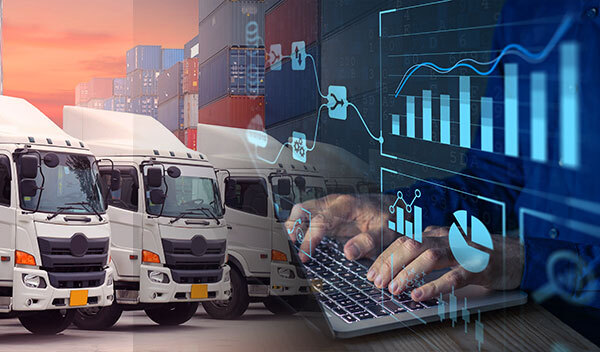Although it has been almost two years since the lifting of global lockdowns, the impact on international freight and logistics is still being felt. Supply chain congestion (also commonly called port congestion) has become a persistent issue worldwide, causing economic strain and disruptions to daily life for many individuals.
However, there are solutions to this problem, some of which are already available. The technology exists to future-proof the trucking business and to alleviate the burden on international ports, but implementation is necessary.
In this post, we will explore several ways in which technology can help to ease supply chain congestion.
Impact of Port Congestion on Supply Chain
As we reflect on the supply chain congestion situation, it would be incomplete not to acknowledge the impact of port congestion on the supply chain. We would be remiss not to mention how the pandemic took a toll on the resilience and perseverance of the nation's carriers.
In 2022, a survey of 500 owner-operators was conducted to gain insight into their experiences related to the supply chain congestion situation. The survey revealed that the industry and carriers were facing significant challenges.
The majority of the owner-operators believed that their job is valued, although this recognition came with a price. Over 66% of those surveyed experienced stress to work extended hours and were concerned about meeting delivery schedules and the future direction of the trucking sector.
Additionally, COVID-19 had resulted in longer work hours and 68% of carriers had restricted their freight pickup and transportation due to concerns about the spread of the virus.
Technological solutions such as transportation management systems (TMS) aim to assist carriers in addressing the challenges of supply chain congestion, supply chain delays, and consumer frustration resulting from delayed deliveries.
By simplifying and expediting freight matching processes, TMS technology enables carriers to focus on delivering goods on time. As smartphones become increasingly essential to their work, carriers are using mobile apps to improve their operations, with nearly half relying on them for their jobs.
A recent survey has found that over 60% of carriers use apps to match freight and find loads, while 59% utilize them to check spot rates. Additionally, carriers are adopting apps to streamline back-end operations, with 58% using technology to receive faster payments and reduce the paperwork that would otherwise take away valuable transport time. This suggests the impact of port congestion on the supply chain.
Alleviate Supply Chain Congestion with Technology
The most popular and advanced ports around the world, such as those located in Abu Dhabi, Rotterdam, and Singapore, are adopting digital breakthroughs to alleviate supply chain congestion.
These technologies include connected platforms, cloud-based services, mobile devices and apps, sensors, and other Internet of Things technologies, which are offering valuable insights into enhancing efficiency and productivity.
Let’s explore these technological innovations in detail.
Internet of Things (IoT)
Due to the apparent need to digitalize the delivery procedures for monitoring cargo and shipping through smart sensors, the Internet of Things (IoT) has emerged as a pivotal aspect of a more extensive technological revolution.
By utilizing IoT technology to deploy sensors that monitor physical assets, managers can geographically reference them to oversee traffic, enhance dispatch efficiency, minimize delays, track and report on the status of loaded and empty containers, organize schedules, and more efficiently allocate arrival times, warehouse capacities, and deliveries.
Blockchain
The utilization of blockchain technology enables ports and deliveries to securely collect and pool data from multiple stages in the supply chain, as well as create tamper-proof records across computer systems.
Inefficiencies are resolved by blockchain technology, particularly in industries reliant on paper-based processes like supply chain management.
Digitalizing supply chains and eliminating manual record-keeping efforts are made possible by blockchain technology, which also facilitates faster and more efficient transactions, as well as real-time communication, thereby streamlining the entire supply chain process.
Drone Technology
The logistics industry is adopting various technologies to improve its operations, and one such technology is drones. In ports, drones are utilized for multiple purposes such as monitoring ships, controlling aerial cargo transport, cleaning the environment, and constructing new terminals.
Additionally, drones can also be used for delivering messages and medium-sized cargo within the port area. The use of drones in port operations addresses safety concerns and dispatch times.
For instance, the implementation of drone technology in the Long Beach port has led to enhanced safety, reduced staff, and rework costs, and improved operational efficiency.
This has resulted in a reduction in the time frame between the arrival and dispatch of containers, leading to better space utilization and organization throughout the process.
High Bay Storage (HBS) System
The system is an automated container handling solution that has the capability to stack containers up to 11 floors high, providing more than three times the capacity of a typical yard.
Recent trials have demonstrated a remarkable reduction of 70% in the land area required to support terminal operations and a substantial increase in space by 300% per hectare when compared to a Rubber Tyred Gantry Crane.
The primary benefit of this system is that it solves the issue of limited space. However, it also offers additional advantages, such as improved handling speed, increased energy efficiency, enhanced safety, and reduced operating costs.
Data and Analytics
Having access to real-time, accurate, and high-quality data enables supply chains to be proactive rather than reactive toward potential risks and issues. For instance, the Maritime and Port Authority of Singapore established a data-driven traffic management tool that predicts vessel arrival times and potential traffic congestion, using predictive analytics.
This approach solves the problem of a speculative and unproductive approach to unforeseen events. By automating core processes such as finance, human resources, transport, and supply chain management, businesses gain actionable insights and reports that help them quickly identify issues, allocate resources, and make permanent improvements.
With data and analytics, ports can be less speculative, and managers can focus on long-term strategies instead of temporary fixes.
Digital Exchange Platforms
These platforms provide a digital solution to the logistics supply chain by establishing a marketplace for various segments of a market. Through these platforms, companies can easily transport their cargo worldwide with just a click of a button, without the need to handle any logistics processes or disruptions that may arise along the way.
This resolves issues of disconnection and inefficient processes by creating networks that allow ports and businesses to access new tools, optimize their routes based on shared data and expert advice, and expand their services by outsourcing to third-party providers such as RCG Logistics.
By doing so, they can avoid delays and additional fees caused by ineffective logistics processes.
Final Thoughts
Given the ongoing supply chain congestion that is spilling over into other areas of business, companies require robust technological systems such as LoadStop to tackle these challenges, ensure customer satisfaction, and sustain profitability.
By leveraging the advanced capabilities, data, and analytics offered by TMS systems, organizations can effectively manage their supply chains, ensuring seamless operations, enhanced safety, and greater predictability.
About the Author: Sara Naveed
Sara Naveed is a creative and digital content writer who uses her creative skills to develop and edit professional web content. Being a writer has always been her dream. She earnestly hopes people appreciate her writing—an asset she deeply covets. Using her 8+ years of working experience, she writes for trucking industry experts who are always looking for better technological solutions to their problems.











